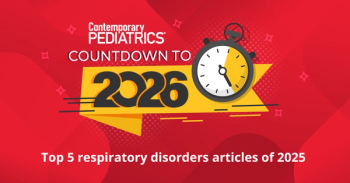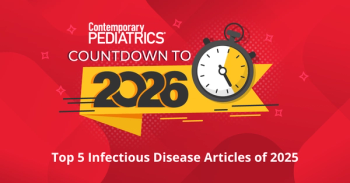
- Vol 35 No 05
- Volume 35
- Issue 05
Boy’s white patches signal pigmentary disorder
A 9-year-old boy presents for evaluation of white spots on his hands, elbows, knees, and legs. There is also a ring around a mole on his back. The patient’s parents first noted areas of depigmentation on his trunk and extremities, and his lesions have spread particularly in areas of trauma. The lesions were most noticeable in the summer when tanning increased the contrast between the involved and uninvolved areas of his body.
The case
A 9-year-old boy presents for evaluation of white spots on his hands, elbows, knees, and legs. There is also a ring around a mole on his back. The patient’s parents first noted areas of depigmentation on his trunk and extremities, and his lesions have spread particularly in areas of trauma. The lesions were most noticeable in the summer when tanning increased the contrast between the involved and uninvolved areas of his body.
Diagnosis: Halo nevus and vitiligo
Discussion
Vitiligo is an acquired pigmentary disorder characterized by depigmented macules and patches that result from the absence of epidermal melanocytes secondary to destruction by autoimmune processes.1 Approximately 0.5% to 2% of the general population is affected, with onset from early childhood to adulthood.1
Vitiligo can affect any part of the body, but usually favors areas that are more darkly pigmented and often traumatized by normal activities including the face, dorsum of hands, elbows, and knees. The development of new lesions in areas of trauma is referred to as a Koebner or isomorphic phenomenon, which is commonly noted in vitiligo.
Segmental and nonsegmental vitiligo are the 2 major forms.2 Segmental vitiligo usually does not cross the midline whereas nonsegmental lesions are usually symmetric and more widely disseminated. Nonsegmental vitiligo is the most common type seen in the pediatric population. Children with a family history of vitiligo have been shown to have an onset as early as age 7 years.3
Halo nevus is a benign melanocytic nevus surrounded by a ring of well-demarcated hypopigmentation or depigmentation.4 It is commonly associated with vitiligo and probably represents a similar autoimmune process.4 Both vitiligo and halo nevus show mononuclear cell infiltrates around the melanocytes with the majority of them being CD8+ T cells.4
In the presence of complete depigmentation, the differential diagnosis includes chemical or drug-induced (eg, imatinib) leukoderma, postinflammatory depigmentation, melanoma-associated leukoderma, and pityriasis versicolor.
Management
Isolated halo nevi can be monitored clinically and usually do not require treatment. Vitiligo poses a major quality-of-life issue particularly for older children and adults. The objectives of treatment include stabilizing pigment loss and triggering factors that need to be considered before choosing a treatment modality, including extent of depigmentation, location, age, skin type, and willingness to adhere to the treatment plan.
After a treatment plan has been started, it takes a minimum of 2 to 3 months to assess the effectiveness of the therapy. Treatment options include topical corticosteroids, topical calcineurin inhibitors such as tacrolimus, narrowband ultraviolet (UV) B, and psoralen plus UVA. Supplementing children with oral vitamin D while receiving topical therapy such as tacrolimus has been shown to be more effective in achieving repigmentation.5
A number of new topical and systemic agents including Janus kinase (JAK) inhibitors are also being considered. The JAK inhibitors have been shown to stabilize the autoimmune process driving the depigmentation, but addition of low-level light is required to achieve repigmentation.
Patient outcome
The patient began treatment with a medium-potency topical steroid applied to the patches on his arms and legs. He was also advised to control sun exposure during the summer.
References:
1. Bolognia JL, Jorizzo JJ, Schaffer JV, et al. Dermatology. 3rd ed. London: Elsevier; 2012:1023-1035.
2. Mohammed GF, Gomaa AH, Al-Dhubaibi MS. Highlights in pathogenesis of vitiligo. World J Clin Cases. 2015;3(3):221-230.
3. Laberge G, Mailloux CM, Gowan K, et al. Early disease onset and increased risk of other autoimmune diseases in familial generalized vitiligo. Pigment Cell Res. 2005;18(4):300-305.
4. Kim YY, Kim MY, Kim TY. Development of halo nevus around nevus spilus as a central nevus, and the concurrent vitiligo. Ann Dermatol. 2008;20(4), 237-239.
5. Karagüzel G, Sakarya NP, Bahadir S, Yaman S, Okten A. Vitamin D status and the effects of oral vitamin D treatment in children with vitiligo: a prospective study. Clin Nutr ESPEN. 2016;15:28-31.
Articles in this issue
over 7 years ago
Hugging is healing for NICU babiesover 7 years ago
Prediabetes: How to identify children at riskover 7 years ago
Plain talk about office practicesover 7 years ago
10 commandments of obesity prevention for childrenover 7 years ago
“Doctor, please don’t call me Mommy!”over 7 years ago
Stock photos miss the boat on safe sleep environmentsover 7 years ago
Social media and sleep duration-there is a connection!Newsletter
Access practical, evidence-based guidance to support better care for our youngest patients. Join our email list for the latest clinical updates.




